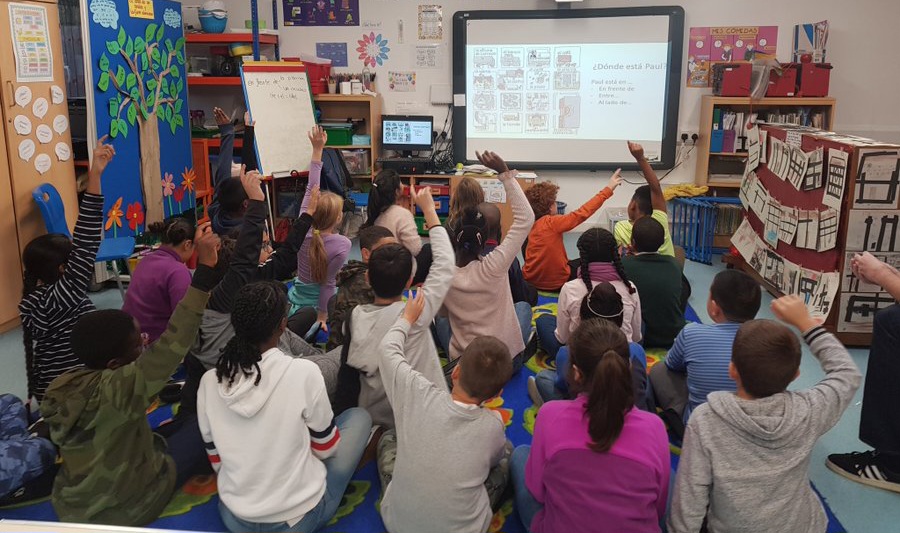This scheme of work for non-specialist teachers was developed in Enfield. It is based around he original KS2 Framework for Languages, and took into account the QCDA materials. It is designed to be adapted by schools to suit their own needs. Yr 3 units are 1-6, yr 4 units are 7-12, yr 5 units are 13-18 and yr 6 units are 19-24. We believe that it delivers the new programme of study for KS2.
Yr 3 – units 1-6
Linguistic diversity in class; where German is spoken; greetings; q and a about name, wellbeing and age; family members; nos. 1-10; phoneme sound au and ch; the alphabet.
Old MacDonald Had a Farm; nos. to 20; familiar playground games; simple Simon says – classroom instructions; favourite playground game; phoneme sound ei and ie.
Celebrating a birthday; achievements in an activity; months; birthday; q and a about birthday; nos. 21-31; days of the week; phoneme sound ä and sh.
Parts of the body, colours; brothers and sisters; physical appearance; phoneme sound ö and ü.
The story Die vier Freunde (The four friends); pets; phoneme sound eu.
Vegetables; likes and dislikes; life cycle of a vegetable; the story of The Giant Turnip; a role play at the market; phoneme sound w.
Units 7-12 yr 4
German-speaking countries; German towns; q and a about where one lives, weather; methods of transport, q and a about how one gets to school; writing an email; phonic focus ei, ig and ch.
Manipulating numbers; more on likes and dislikes; the Euro; preparing and performing a radio or TV advert for a toy; phonic focus on d and z.
The story of Sleeping Beauty; nouns, adjectives and verbs; manipulation of numbers; simple sentence building; phonic focus on phoneme ö.
Revising and learning new sports; food and drinks re healthy and unhealthy lifestyles; revising the days of the week; learning to say what activities one does on particular days; phonic focus on sp, j and v sounds.
The “Carnival of the Animals” by Saint-Saëns; describing animals characterized by the music; talking about their habitats; time on the hour (analogue only); phonic focus on w, a, ö, ü and z.
Aesop’s fable Die Sonne und der Wind (The Sun and Wind); clothing and relating these to the weather; date; phoneme sounds ie, ei, ig, ö and z.
Units 12-18 Yr 5
Food and drink related to packed lunches, snacks and celebrations (e.g. Karneval); past tense; recipes; phonic focus on a and ö.
Musical preferences; instruments one plays; adaptation of the song “I am the Music Man”; exploring rhythm; creating a rap or song; focus on phonemes ch and w.
Understanding and using names for places in local area; following and giving directions; describing route to school; phonic focus on ch, aus, ü, a, ä, u and o.
Describing a painting – Kreidenfelsen auf Rügen (“Chalk Cliffs on Rügen”) by Caspar David Friedrich; using knowledge to write and perform own poetry inspired by the painting; phonic focus on st.
Describing seasons in the context of a poem “Der Frühling kommt wieder” and the music from Vivaldi’s “The Four Seasons”; past tense; phonic focus on ö, ü, ä, w and ch.
The planets; constructing sentences using verbs, nouns, adjectives and qualifying adverbs; presenting knowledge using ICT or by making a booklet; phoneme focus on a, e, u.
Units 19-24
Places around school; everyday routines and school subjects; time on half-hour and quarter hour; timetables; 24-hour clock; comparing school in UK with school in German speaking countries; past tense; phonic focus on v.
The Rhine and geographical features of the countries it flows through; future tense re weather; planning exploration of an imaginary river for presentation; phonic focus on eu and ä.
Asking for drinks, snacks and ice creams; past tense re food and drink; dialogues in café; recipe for a milkshake and justification of choice; dictionary use; phonic focus on ei, ü, sp, ch, o, ie and eu.
Describing places in a town now and in past; new adjectives and places in town; practice with texts about towns in Germany; producing tourist guide to own town; phonic focus on
z.
Rides at a theme park; numbers up to 100; creating text re visit to theme park; favourite ride; phonic focus on ch.
Looking at German newspapers; different columns/sections; producing texts for a class newspaper; consolidating and celebrating what has been learnt during key stage 2; phonic focus on all sounds.
